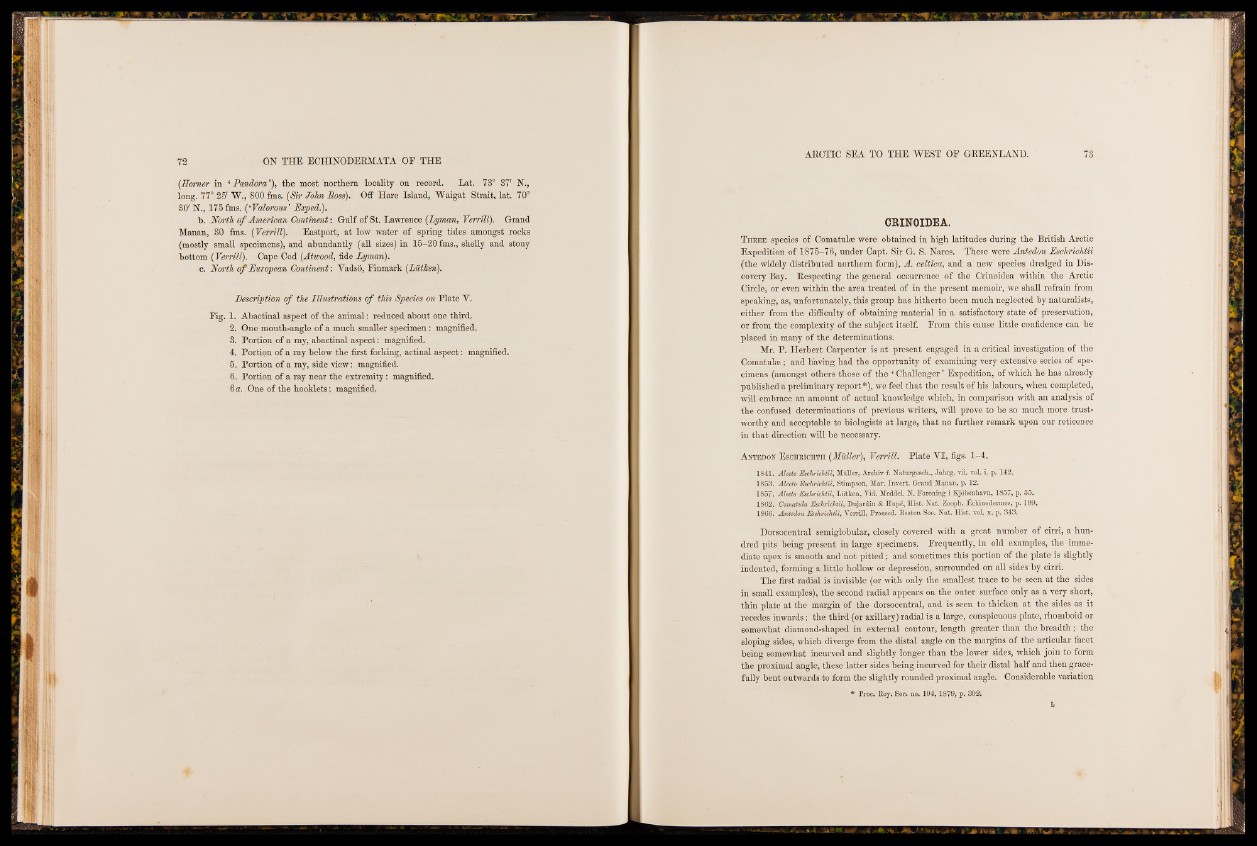
(Hamer in ‘ Pandora ’), the most northern locality on record. Lat. 73° 37' N.,
long. 77° 25' W., 800 fms. (Sir John Moss).. Off Hare Island, Waigat Strait, lat. 70°
30' N., 175 fms. (‘Valorous * Exped.).
b. North o f American Continent: Gulf of St. Lawrence (Lyman, Verrill). Grand
Manan, 30 fms. (Verrill). Eastport, at low water of spring tides amongst rocks
(mostly small specimens), and abundantly (all sizes) in 15-20 fms., shelly and stony
bottom ( Verrill). Cape Cod (Atwood, fide Lyman).
c. North o f European Continent: Vadso, Finmark (Lutiken).
Description o f the Illustrations o f this Species on Plate Y.
Fig. 1. Abactinal aspect of the animal: reduced about one third.
2. One mouth-angle of a much smaller specimen: magnified.
3. Portion of a ray, abactinal aspect: magnified.
4. Portion of a ray below the first forking, actinal aspect: magnified.
5. Portion of a ray, side view: magnified.
6. Portion of a ray near the extremity: magnified.
6 a. One of the hooklets; magnified.
73
CRINOIDEA.
T h r e e species of Comatulse were obtained in high latitudes during the British Arctic
Expedition of 1875-76, under Capt. Sir G. S. Nares. These were Antedon Eschrichtii
(the widely distributed northern form), A. celtica, and a new specie^ dredged in Discovery
Bay. Respecting the general occurrence of the Crinoidea within the Arctic
Circle, or even within the area treated of in the present memoir, we shall refrain from
speaking, as, unfortunately, this group has hitherto been much neglected by naturalists,
either from the difficulty of obtaining material in a satisfactory state of preservation,
or from the complexity of the subject itself. From this cause tittle confidence can be
placed in many of the determinations.
Mr. P. Herbert Carpenter is at present engaged in a critical investigation of the
Comatulse; and having had the opportunity of examining very extensive series of specimens
(amongst others those of the ‘ Challenger ’ Expedition, of which he has already
published a preliminary report*), we feel that the result of his labours, when completed,
will embrace an amount of actual knowledge which, in comparison with an analysis of
the confused determinations of previous writers, will prove to be so much more trustworthy
and acceptable to biologists at large, that no further remark upon our reticence
in that direction will be necessary.
A n tedon E schrichtii (Müller), Verrill. Plate VI, figs. 1-4.
1841. Alecto Eschrichtii, Müller, Archiv f. Haturgesch., Jahrg. vii. vol. i. p. 142..
1853. Alecto Eschrichtii, Stimpson, Mar. Invert. Grand Manan, p. 12.
1857. Alecto Eschrichtii, Lütken, Yid. Meddel. N. Forening i Kjöfeenhavn, 1857, p. 55.
1862. Gomatula Eschrichtii, Dujardin & Hupe, Hist. Nat.Zooph. Echinodermes, p. 199»
1866. Antedon Eschrichtii, Verrill, Proceed. Boston Soc. Hat. Hist. voL x.,p. 343.,
Dorsocentral semiglobular, closely covered with a great number of cirri, a hundred
pits being present in large specimens. Frequently, in old examples, the immediate
apex is smooth and not pitted; and sometimes this portion of the plate is slightly
indented, forming a little hollow or depression, surrounded on all sides by cirri.
The first radial is invisible (or with only the smallest trace to be seen at the sides
in small examples), the second radial appears on the outer surface only as a very short,
thin plate at the margin of the dorsocentral, and is seen to thicken at the sides as it
recedes inwards; the third (or axillary) radial is a large, conspicuous plate, rhomboid or
somewhat diamond-shaped in external contour, length greater than the breadth; the
sloping sides, which diverge from the distal angle on the margins of the articular facet
being somewhat incurved and slightly longer than the lower sides, which join to form
the proximal angle, these latter sides being incurved for their distal half and then gracefully
bent outwards to form the slightly rounded proximal angle. Considerable variation
* Proc, Roy. Soc». no» 1 9 4 ,1 8 7 9 , p. 392.